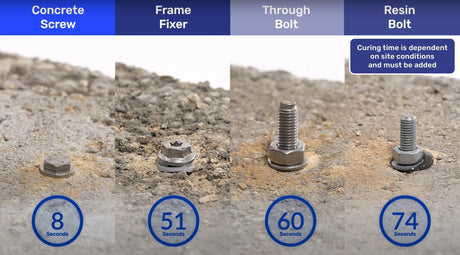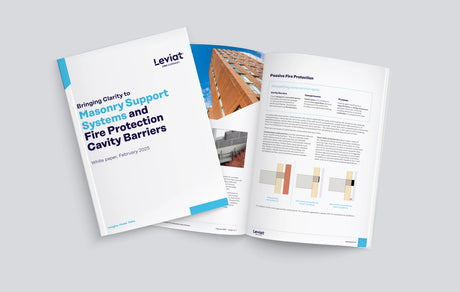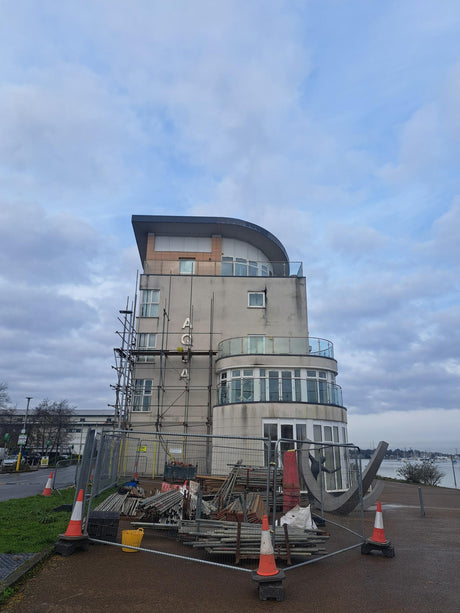When you're building or renovating in the UK, a big decision you might face is whether to use stainless steel or galvanised steel fixings. Upon conducting a quick Google search, you'll quickly notice that stainless steel fixings consistently cost a lot more upfront - often several times the price of their galvanised counterparts, but why is this?
At Certifix, we operate, like you, in an extremely congested industry with lots of competition and as such, we are regularly exposed to price competitiveness. The real financial difference becomes clearer when you look at the long-term performance, maintenance, and lifespan of these two materials. It's often this bigger picture that should be considered and will depend significantly, on the application, the design life and aesthetic you want to achieve.
Table of Contents
- Why Is Stainless Steel So Much More Expensive?
- The Real Cost: A Look at the Long-Term
- When Does It Make Sense to Pay More for Stainless Steel?
- When Does It Make Sense to use a Galvanised Product instead?
- The Bottom Line
Why Is Stainless Steel So Much More Expensive?
The main reason for the price difference comes down to what's inside the metal itself. Stainless steel isn't just regular steel; it's an alloy. To be called "stainless," it has to contain at least 10.5% chromium, plus other more expensive elements like nickel, which are traded as commodities on the global market and can account for almost 2/3rds of the material itself (around 8% for A2 and 11-12% for A4). These special ingredients make the steel incredibly resistant to rust, but, as you would imagine, they also make it more costly to produce. Makes sense, doesn’t it?
Galvanised steel, on the other hand, starts as a cheaper carbon steel. It's then given a protective coating of zinc. While the process of hot-dip galvanisation adds to the cost, it’s still far less than the premium you pay for the special mix of metals in stainless steel. Take a basic bag of screws for example, you might find stainless steel costs three to five times more than a galvanised version. For bigger, more specialised fixings, that price gap gets even wider.
See the example below. 3 of the same type of Certifix CFTB through bolts but made from Hot dipped Galvanised steel, Zinc Plated and A4 Stainless Steel (prices current at time of writing):

The Real Cost: A Look at the Long-Term
To truly understand the value of any premium product (both these finishes are), you have to look beyond the initial purchase and consider the cost and application. In layman’s terms, think of it like buying a pair of shoes. A really cheap pair may be better walking on rough terrain than bare feet offering you improved protection and comfort, however versus a well-made durable pair, the latter should provide even more of both for a longer period of time. Equally, you wouldn't buy a ballerina shoe if you wanted to run a marathon.
-
Design Life, Rust Resistance and How Long They Last: This is the biggest deal. Galvanised steel’s protection is a sacrificial zinc coating that gradually wears away, especially in harsh environments. Once it's gone, the steel underneath starts to rust. In a calm, rural part of the UK, this might take decades. But in a busy city or, even worse, by the coast with all that salt in the air, that coating can fail in just 5 to 10 years. In coastal regions, metals can see corrosion of 13-25 microns per year, and galvanising is often manufactured to 50 microns so effectively you have a 2 year life span in such applications. The Galvanizers Association provides detailed data on how zinc coatings perform differently in various UK environments, confirming this variability [1]. Stainless steel’s rust-proofing, however, is built-in. It doesn’t chip or wear away. A special type of "marine grade" stainless steel (A4 or Grade 316) is specifically designed to handle salty coastal air, often outliving the building itself [2].
-
Cost of Repairs and Upkeep: When a galvanised fastener fails, it's not just the fastener you have to replace. You have to pay for a contractor, scaffolding, and all the labour, which can quickly turn a small job into a major project. Because stainless steel holds up so well, you can minimise the risk of experiencing these expenses, particularly in the short to medium term.
-
Looks and Style:
If the fixings are going to be seen, their appearance matters. Galvanised fixings have a dull, grey finish that can look a bit rough over time and can leave rust streaks on the surrounding material. Stainless steel has a clean, modern look that it maintains for a lifetime without staining anything around it. For some, the aesthetic of a building is as important as it’s durability.
- Structural Strength: High-quality stainless steel fixings are built for both strength and rust resistance. The British Standard BS EN ISO 3506 outlines the mechanical properties and grades of stainless steel fixings, such as the high-strength A4-80 grade, which is cold-worked to achieve the strength of many carbon steel fixings while retaining superior corrosion resistance [3].
When Does It Make Sense to Pay More for Stainless Steel?
While the initial price might make you think twice, there are some situations in the UK where using stainless steel is a no-brainer.

-
By the Coast or in Salty Areas: The salty air near the sea is a nightmare for galvanised steel. It will eat through the zinc coating in no time. For coastal projects, A4-grade stainless steel isn't just a good idea; it's the only smart choice to prevent costly failure [2]. At Certifix, we have been involved in a number of coastal projects and seen first hand how this harsh environment can literally eat away at fixings (see the cautionary tale at the foot of this article for an example).
-
Facades and Cladding: Modern building regulations, like the UK's Building Safety
Act 2022, have placed a strong emphasis on using non-combustible materials for external walls and their attachments on buildings over 11 metres [4]. This includes fixings. Approved Document B of the Building Regulations provides guidance that requires fixings to have an A2 or better fire rating, which stainless steel inherently has. Trying to save money with a cheaper alternative could lead to a very expensive, and risky, re-do later on [5]. Would you take that risk when lives could be at stake?
-
Safety Critical Applications: According to BS 8539 BS EN 1992-4, the definition of 'safety critical' is where failure may result in:
• Death or serious injury to people
• Loss or severe damage to equipment/property
• Environmental harm
• Major disruption to public services, etcApplications such as aerospace, medical, food processing, chemical/pharmaceutical manufacturing and infrastructure are examples of where worker safety, contamination and corrosion can be considered factors that demand the use of stainless over other materials.
-
When Fastening Wood: If you're working with certain types of wood like oak or cedar, their natural acids can actually eat away at a galvanised coating. Stainless steel, however, won't react with the wood, ensuring a solid, long-lasting connection.
- Extended Design Life: When applications require durability over decades, A4 stainless comes into its own. With an expected design life of over 50 years, these fixings are the obvious go-to solution, particularly in some of the harsher conditions we’ve already touched upon.
When Does It Make Sense to use a Galvanised Product instead?
It’s important to note that galvanised fixings are perfectly suitable for more than half of the constructions within the UK i.e. if they don’t fall into the categories above. Not every project requires the benefits that stainless versions offer so it’s key you understand their benefits, so you don’t discount them from your next project unnecessarily.
-
Cost-Effectiveness: As we’ve discussed, Hot-dip galvanised fixings are significantly cheaper than stainless steel. This makes them the preferred choice for large-scale construction projects or when working to a tight budget, as they can provide excellent corrosion protection at a fraction of the cost.
-
Thick, Durable Coating: The hot-dipping process creates a thick, robust zinc-iron alloy layer that is metallurgically bonded to the steel. This coating is much thicker and more abrasion-resistant than the electroplated zinc on a standard zinc-plated fixing. This provides a high level of protection in many outdoor environments when compared to standard zinc plated fixings.
-
Suitability for Specific Environments: For many outdoor applications, especially in inland, non-marine environments, a galvanised coating provides sufficient protection for a very long lifespan. The Galvanizers Association in the UK provides data showing that in rural areas, a typical 85µm coating can last over 85 years with minimal maintenance. [1]
The Bottom Line
When you get a quote for a construction project, the cost of stainless steel fixings will look high compared to galvanised ones for the main reason we have outlined – the production process.
For any UK project that has to stand up to severe weather, last for a long time, or is critical for safety, the case for stainless steel, like the material itself, is very strong. It might feel like a premium purchase at the start, but its durability, lack of maintenance, and ability to meet strict regulations mean it's an investment that will potentially save you a lot of money and headaches down the line.
If these are not your prime concerns, but you want that added protection over a standard zinc plated fastener or fixing, hot dipped galvanised could still be a viable option. It's really down to you (or your customer/client) which option you choose at the end of the day. It's like the shoe analogy we mentioned before, it all depends on your usage and what performance you are looking for from your fixing or fastener. At Certifix, we can help with that decision should you need some assistance with deciding.
Case Study
The critical importance of correct material specification was laid bare during the reconstruction of a coastal multi-storey car park in 2017 - the replacement for a structure previously lost to a devastating fire which tore through over 1,000 vehicles causing an estimated bill of £20m.
Certifix was tasked with supplying the fasteners for the new build in the same high-risk, corrosive environment. Despite our strong reservations during the quotation phase, the contractor sought to shave approximately £2,000 from the original quote by insisting on replacing the stainless steel fasteners we offered with cheaper galvanised fixings. Their rationale was that the fixings should match the galvanised steel of the building’s primary structure.
The inevitable consequences arrived quickly. Just six weeks after installation, we were contacted regarding severe corrosion across the project, triggering an inquiry into whether the fixings met EN ISO 1461 [1] - a standard that had never been requested during the purchasing process.
This cost-cutting error in specification not only required the client to spend an unbudgeted £10,000+ to replace all the corroded fixings with suitable stainless steel versions, but it also resulted in significant reputational damage.
We too learned a valuable lesson: as a professional fixing supplier, we now adhere to a non-negotiable policy. We will not authorise the use of galvanised anchors in coastal or high-risk corrosive environments, regardless of the commercial pressure to do so. This story underscores why short-term cost savings and incorrect specification can lead to devastating long-term project failure.
References
- Galvanizers Association. Knowledge Hub. This resource provides data on the corrosion rates of galvanised steel in different atmospheric conditions across the UK including EN ISO 1461
- British Stainless Steel Association (BSSA). Stainless Steel Fasteners. The BSSA offers technical guidance on the properties of different stainless steel grades.
- British Standards Institution (BSI). BS EN ISO 3506: Fasteners. Mechanical properties of corrosion-resistant stainless steel fasteners - Bolts, screws and studs with specified grades and property classes. This is the key standard that specifies the mechanical and physical properties of stainless steel fixings, including their tensile strength and proof stress for different property classes.
- UK Government. The Building Safety Act 2022. The legislation that introduced new responsibilities for building owners and a regulatory regime to ensure building safety, particularly concerning fire and structural integrity.
- Department for Levelling Up, Housing and Communities (DLUHC). Approved Document B (Fire Safety). This guidance document outlines the UK's fire safety requirements for buildings, including the use of non-combustible materials (Class A2-s1, d0 or better) in external walls and specified attachments on buildings over 11 metres.








